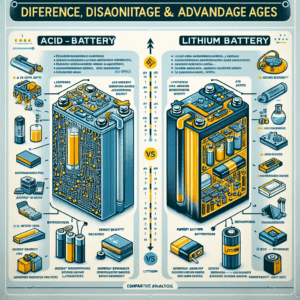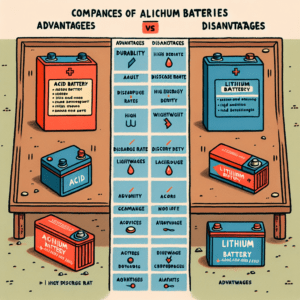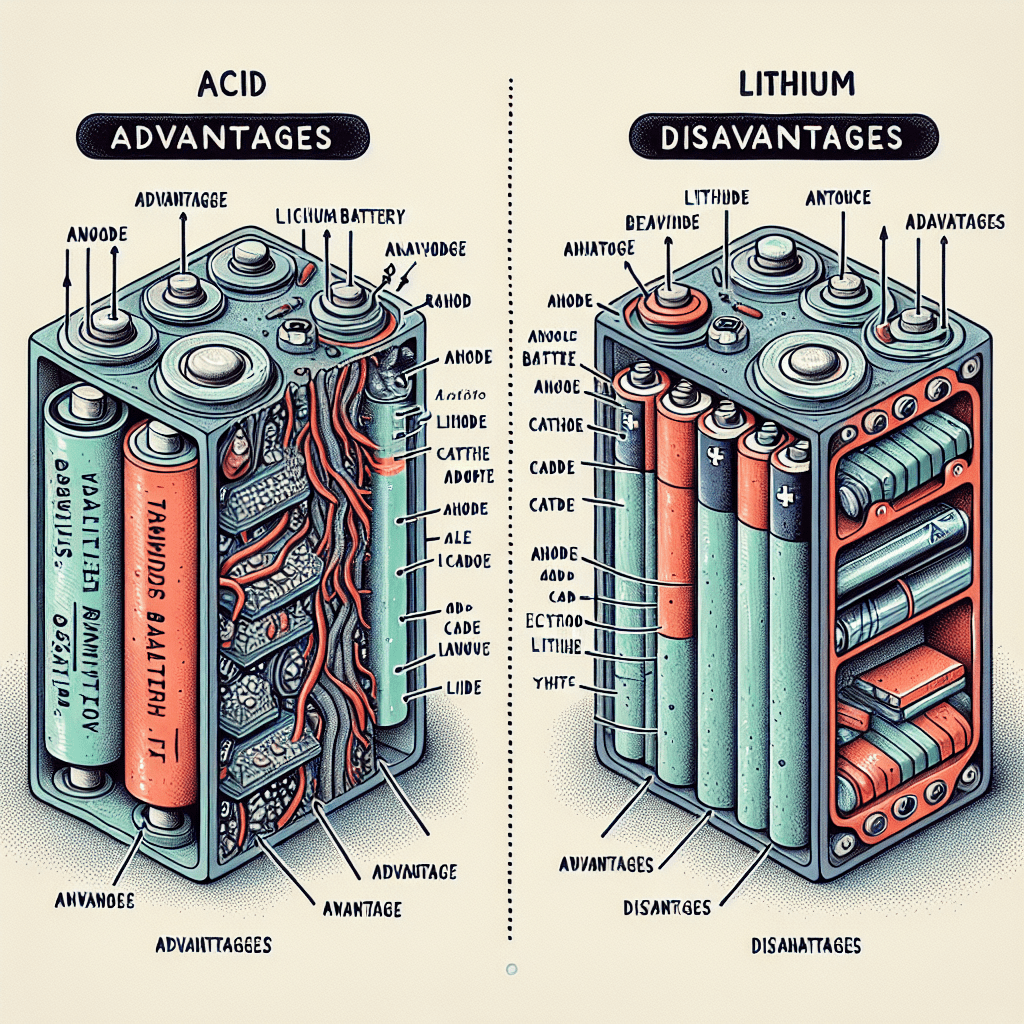ITEACH.TOP | LEARN EVERYTHING
Introduction to Battery Technologies: Acid vs. Lithium
In the ever-evolving landscape of battery technologies, lead-acid and lithium-ion batteries remain among the most prominent contenders. While lead-acid batteries have a long-standing history, lithium-ion batteries have surged in popularity due to advances in technology and increasing demand for efficient energy storage solutions. This article will meticulously examine the differences, advantages, and disadvantages of these two battery types, providing a thorough understanding for informed decision-making.
Chemical Composition: Comparing Lead-Acid and Lithium Batteries
Lead-acid batteries consist of lead dioxide and metallic lead as their primary active materials, with sulfuric acid serving as the electrolyte. Conversely, lithium-ion batteries feature a complex chemical composition, typically involving lithium cobalt oxide for the cathode and graphite for the anode, with lithium salt in an organic solvent as the electrolyte. The choice of materials directly impacts the batteries’ performance, efficiency, and environmental footprint.
Lead-acid batteries are characterized by their heavy metals and corrosive electrolytes, which can be hazardous to both users and the environment. On the other hand, lithium-ion batteries, although containing less toxic materials, can pose risks due to their flammability and reactive nature. These chemical properties underline the importance of safe handling and appropriate technological applications for each battery type.
Energy Density: Which Battery Type Delivers More Power?
Energy density, measured in watt-hours per kilogram (Wh/kg), is a critical parameter that determines the power a battery can deliver relative to its weight. Lead-acid batteries typically offer an energy density ranging from 30 to 50 Wh/kg, which is comparatively lower than lithium-ion batteries that can achieve up to 250 Wh/kg. This higher energy density of lithium-ion batteries makes them more suitable for applications requiring compact, lightweight energy storage solutions.
The superior energy density of lithium-ion batteries translates into longer operational times and reduced weight for end-use applications such as electric vehicles (EVs) and portable electronics. By contrast, the lower energy density of lead-acid batteries necessitates larger, heavier battery systems to achieve the same power output, which can limit their applicability in scenarios where space and weight are critical considerations.
Cycle Life: Longevity of Lead-Acid vs. Lithium Batteries
Cycle life, defined as the number of complete charge-discharge cycles a battery can endure before its capacity drops below a specified threshold, is another vital performance metric. Lead-acid batteries generally exhibit a cycle life of around 300–500 cycles, while lithium-ion batteries can achieve upwards of 1,000–3,000 cycles, depending on the specific chemistry and usage conditions.
The extended cycle life of lithium-ion batteries offers a distinct advantage in applications demanding long-term reliability and minimal maintenance, such as grid energy storage and renewable energy systems. Meanwhile, the shorter cycle life of lead-acid batteries often necessitates more frequent replacements, contributing to higher long-term costs and environmental impacts due to increased waste generation.
Charging Time: Efficiency of Recharging
Charging time is crucial for applications requiring rapid battery turnaround. Lead-acid batteries typically experience longer charging times, often requiring 8–16 hours for a full recharge due to their inherent electrochemical processes. Lithium-ion batteries, however, benefit from advanced charging technology, often requiring only 1–3 hours to reach full charge, contingent on the charger and battery design.
The fast-charging capability of lithium-ion batteries is particularly advantageous for applications such as electric vehicles and consumer electronics, allowing for reduced downtime and increased efficiency. In contrast, the extended charging times associated with lead-acid batteries can hinder their practicality in environments where quick charge turnaround is essential.
Weight Considerations: Acid vs. Lithium Batteries
Weight is a significant factor in applications where mobility and ease of installation are crucial. Lead-acid batteries are substantially heavier due to their dense lead content, which can render them impractical for portable or weight-sensitive applications. Lithium-ion batteries, with their lighter lithium compounds, offer a much more favorable weight-to-performance ratio.
The reduced weight of lithium-ion batteries translates to improved portability and easier handling, making them ideal for use in electric vehicles, aerospace applications, and portable electronics. Conversely, the heavier lead-acid batteries are often confined to stationary applications such as backup power systems and large industrial equipment where weight is less of a concern.
Cost Analysis: Upfront and Lifetime Expenses
Initial cost is often a primary consideration when selecting battery technology. Lead-acid batteries are generally more affordable upfront, with lower initial purchase prices compared to lithium-ion batteries. However, the total cost of ownership, which includes maintenance, replacement, and operational expenses, can be significantly higher for lead-acid batteries due to their shorter cycle life and frequent servicing requirements.
Lithium-ion batteries, despite their higher initial cost, often prove more economical over the long term due to their extended cycle life, lower maintenance needs, and superior energy efficiency. This disparity in cost dynamics underscores the importance of evaluating both upfront investment and long-term expenses when choosing the appropriate battery technology for specific applications.

Environmental Impact: Lead-Acid vs. Lithium Batteries
The environmental impact of battery technologies encompasses several factors, including resource extraction, manufacturing processes, usage, and end-of-life disposal. Lead-acid batteries, with their reliance on heavy metals and corrosive chemicals, pose substantial environmental risks during both production and disposal, contributing to soil and water contamination if not properly managed.
Lithium-ion batteries, while generally considered less environmentally detrimental during use, present challenges related to lithium mining and the disposal of chemical residues. However, advances in recycling technologies and the development of more sustainable sourcing methods are progressively mitigating these environmental impacts. An awareness of the lifecycle environmental footprint of each battery type is essential for sustainable decision-making.
Maintenance Requirements: Acid Batteries vs. Lithium Batteries
Maintenance is a pivotal factor influencing the practical deployment of battery systems. Lead-acid batteries traditionally require regular maintenance to ensure optimal performance, including electrolyte level checks, terminal cleaning, and equalization charges to prevent sulfation. This routine upkeep can be labor-intensive and add to the overall operational costs.
Lithium-ion batteries, conversely, boast a relatively maintenance-free operation, with no need for regular upkeep or servicing in most applications. This ease of use makes lithium-ion batteries particularly appealing for users seeking hassle-free, reliable energy storage solutions. The reduced maintenance demands of lithium-ion batteries contribute significantly to their growing popularity across various sectors.
Safety Profiles: Assessing Risks of Each Battery Type
Safety is paramount when selecting battery technology, particularly for applications involving human interaction. Lead-acid batteries pose risks related to acid spills, hydrogen gas emissions, and short-circuiting, necessitating stringent safety measures during handling and use. Proper ventilation, protective equipment, and spill containment are crucial to mitigate these hazards.
Lithium-ion batteries, while generally safer in terms of chemical exposure, can be prone to thermal runaway and fire if damaged or improperly managed. The flammability of their electrolytes means that overheating, overcharging, or physical damage can lead to hazardous incidents. Implementing robust battery management systems (BMS) and adhering to manufacturer guidelines are pivotal to maintaining the safety of lithium-ion battery systems.
Temperature Performance: How They React to Extreme Conditions
Batteries’ performance can be significantly influenced by temperature, with both types exhibiting distinct behaviors under extreme conditions. Lead-acid batteries typically perform well at moderate temperatures but can suffer from diminished capacity and increased wear in cold environments. High temperatures, meanwhile, can accelerate electrolyte evaporation and hasten degradation.
Lithium-ion batteries generally offer superior performance across a wider temperature range, maintaining efficiency at both low and high extremes. However, they can still experience capacity loss and potential safety issues when exposed to severe cold or excessive heat. Implementing temperature management systems can enhance the resilience and reliability of battery systems in diverse environmental conditions.
Applications: Suitable Uses for Each Battery Type
The distinct characteristics of lead-acid and lithium-ion batteries cater to different application niches. Lead-acid batteries, with their robust architecture and lower initial costs, are well-suited for stationary energy storage, automotive starter batteries, and industrial backup systems. Their reliability in high-power, low-energy applications makes them a go-to choice for many traditional uses.
Lithium-ion batteries, due to their high energy density, lightweight, and fast-charging capabilities, are increasingly preferred for portable electronics, electric vehicles, and renewable energy integration. Their versatility and advanced performance profiles enable their deployment in cutting-edge technologies and innovations, driving significant growth in emerging market sectors.
Discharge Rates: Energy Output Efficiency
Discharge rate, or the rate at which a battery releases its stored energy, is a crucial parameter that affects performance and efficiency. Lead-acid batteries typically exhibit lower discharge rates and can suffer from a phenomenon known as “voltage sag,” where the voltage drops significantly under high loads. This limits their effectiveness in applications requiring consistent, high-power output.
Lithium-ion batteries deliver superior discharge rates, maintaining stable voltage and performance across a broad range of loads. This ability to efficiently manage high discharge demands makes lithium-ion batteries an optimal choice for applications requiring reliable, high-energy delivery, such as power tools, computing devices, and high-performance electric vehicles.
Technological Advancements: Future of Battery Technologies
Battery technology is a dynamic field with continuous advancements aiming to enhance performance, safety, and sustainability. Lead-acid batteries have benefited from incremental improvements such as advanced grid technology and better active material formulations, enhancing their efficiency and lifespan. However, the fundamental chemistry imposes inherent limitations on significant gains.
Lithium-ion batteries are at the forefront of innovation, with ongoing research focused on higher-capacity materials, solid-state electrolytes, and advanced manufacturing techniques. These advancements promise to further improve energy density, cycle life, safety, and environmental footprint. Emerging technologies such as lithium-sulfur and lithium-air batteries hold the potential to revolutionize energy storage in the near future.
Compatibility with Renewable Energy Systems
The growing emphasis on renewable energy integration necessitates highly efficient and compatible battery storage solutions. Lead-acid batteries, with their proven reliability and cost-effectiveness, have been widely used in solar and wind energy systems for decades. However, their lower energy density and shorter cycle life can limit their scalability in large, modern renewable energy installations.
Lithium-ion batteries offer enhanced synergy with renewable energy due to their superior energy density, long cycle life, and fast response times. These attributes make lithium-ion batteries well-suited for balancing grid demands, storing excess renewable energy, and providing backup power. Their scalability and efficiency support the transition towards more resilient, clean energy infrastructures.
Availability and Supply Chain: Acid vs. Lithium Batteries
The availability and supply chain considerations for battery technologies impact their accessibility and cost. Lead-acid batteries benefit from a well-established supply chain with abundant, relatively low-cost materials and widespread manufacturing capabilities. This infrastructure supports their consistent availability and competitive pricing.
Lithium-ion batteries, although more complex, benefit from rapidly expanding production capacity and increasing investment in mining and refining lithium and other critical materials. The global supply chain for lithium-ion batteries is becoming increasingly robust, driven by soaring demand from the automotive, electronics, and energy sectors, albeit with considerations for geopolitical and resource supply challenges.

Recycling and Disposal: Environmental Impact and Regulations
The end-of-life management of batteries is crucial for minimizing environmental impact and adhering to regulatory standards. Lead-acid batteries are highly recyclable, with established processes allowing for the recovery of up to 99% of their materials, including lead and sulfuric acid. This high recyclability mitigates environmental harm and supports a circular economy.
Lithium-ion batteries, while less established in recycling processes compared to lead-acid batteries, are gaining traction with new technologies for material recovery and reuse. Efficient recycling methods are emerging to address the complex chemistries and recover valuable components like lithium, cobalt, and nickel. Regulations and industry initiatives are driving improvements in the sustainable disposal and recycling of lithium-ion batteries.
Durability and Robustness: Comparing Structural Integrity
Durability and robustness are critical factors in assessing a battery’s performance in demanding environments. Lead-acid batteries are known for their rugged construction and ability to withstand mechanical stress, which makes them suitable for harsh industrial conditions. However, their sensitivity to deep discharges and sulfation can compromise their longevity if not appropriately managed.
Lithium-ion batteries, while typically less mechanically robust, offer superior performance in terms of resistance to deep discharges and cycling durability. Their advanced internal structures and protective measures enable them to maintain efficiency and integrity over prolonged use, even in applications requiring frequent charge-discharge cycles.
Performance Under Load: Real-World Applications Tested
The real-world performance of batteries under various load conditions provides insights into their practical effectiveness. Lead-acid batteries can experience performance degradation under high continuous loads, with issues such as voltage droop and reduced capacity. This limits their utility in applications demanding consistent, high-power output.
Lithium-ion batteries excel in high-load scenarios, maintaining stable voltage and performance without significant degradation. Their ability to deliver consistent energy under varying load conditions makes them highly suitable for high-demand applications such as electric vehicles, power tools, and critical infrastructure backup systems.
User Experience: Practical Advantages and Disadvantages
From a user experience perspective, both lead-acid and lithium-ion batteries offer unique advantages and disadvantages. Lead-acid batteries provide a reliable, cost-effective solution for applications where weight and size are not critical, and they benefit from well-established maintenance and recycling programs. However, their lower energy density and frequent maintenance requirements can be seen as significant drawbacks.
Lithium-ion batteries offer a more user-friendly experience with superior energy density, minimal maintenance needs, and faster charging times. These attributes are particularly appealing for consumer electronics, portable devices, and emerging technologies requiring high efficiency and reliability. Nevertheless, higher upfront costs and potential safety concerns necessitate careful management and adherence to best practices.
Conclusion
Understanding the differences, advantages, and disadvantages of lead-acid and lithium-ion batteries is essential for selecting the appropriate energy storage solution for specific applications. Each battery type brings distinct benefits and challenges, making them suitable for diverse uses ranging from industrial backup to cutting-edge electronics. By carefully considering factors such as chemical composition, energy density, cycle life, charging time, and environmental impact, users can make informed decisions that align with their technical and practical needs. As battery technology continues to advance, the balance of advantages between lead-acid and lithium-ion batteries will evolve, driving further innovation and efficiency in energy storage systems.







